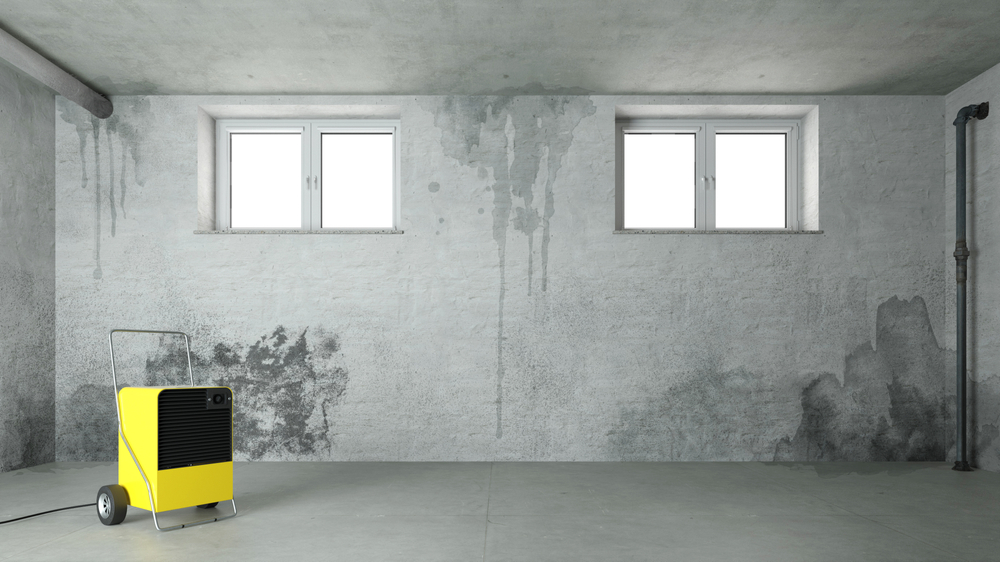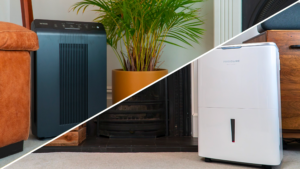If you don’t have sufficient ventilation in your basement, then you may encounter serious problems, such as health issues, too much moisture in your basement, mold and mildew, pests, bad smells, and even structural damage to your home.
Fortunately, there are many easy ways to ventilate your basement, including opening windows and doors, installing a mechanical ventilation system, or by operating a fan, air purifier, or dehumidifier. Many of these solutions are cost-effective and can save you a ton of time, money, and stress down the road.
Why is it important to ventilate your basement?
Hot air rises, and if you don’t have proper ventilation in your basement, then you can end up with some pretty serious problems, not to mention a possible prolonged exposure to radon.
Keep reading to learn more about the top six reasons why you need to improve the air quality in your basement:
Your health. Improper ventilation can lead to a number of serious health complications. Air needs to circulate and be replaced with fresh oxygen; if this doesn’t occur, then you’ll be breathing in stale air which contains an excess of toxins, pollutants, and other airborne contaminants, all of these things can cause eye, nose, and throat irritation. For those with respiratory issues and pre-existing lung conditions, the damage from bad air quality can be even worse.
Presence of mold and mildew. Excess humidity can cause mold and mildew, which is a very serious problem that can lead to a number of severe health conditions. What’s more, mold and mildew can also damage your home. When mold and mildew are left unchecked, they can damage the structural integrity of your property and sometimes even render your home uninhabitable until they are professionally removed.
Damage to walls, ceilings, and paint. High humidity can cause serious damage to your walls, ceilings, and paintwork. When moisture gets into your walls, it seeps into the paint, which can cause it to chip, crack, and peel away. This might sound like a minor thing, but anyone who’s ever had to repair cracked paint will tell you just how much of a nightmare this can be.
Bad smells and odors. If you don’t have proper ventilation in your basement, then it’s only a matter of time before things start smelling funky, and that’s putting it mildly. Darkness and moisture are a very bad combination when it comes to foul odors, and these sorts of smells can last for a long time, often proving very difficult to eliminate from your home.
Perfect conditions for pests. All sorts of insects and other pests are attracted to warm, moist environments, so your basement might be very appealing to them. Poor ventilation and too much moisture can lead to an infestation of ants, rodents, cockroaches, termites, fleas, and more. Any one of these pests will cost a significant amount of money to remove. In some cases, such as with termites, these pests might even cause permanent damage to your home, which would cost even more money to repair.
Damage to wood furnishings. If you have too much humidity in your basement, then you will eventually notice that the furniture and other wooden features in your home begin to deteriorate. Mold and moisture can settle into the wood, which can break down the fine finishes on your furniture and floors, sometimes even ruining these features permanently.
Let’s go over some easy ways in which you can ventilate your basement without breaking the bank.
How to improve basement ventilation

The good news is that there are plenty of ways you can add ventilation to your basement, which will dramatically reduce the odds that you’ll encounter any of the problems mentioned above. So, let’s go over the best ways to ventilate your basement so that you can save yourself a ton of time and money dealing with these sorts of problems in the future.
1. Natural ventilation alternatives
Natural ventilation simply means having adequate airflow. When you allow the air to flow and cycle naturally throughout your basement, moisture will gradually evaporate, which will decrease the odds of you encountering issues.
- Windows. Not all homes are lucky enough to have windows in the basement, but if yours does, then you should definitely take advantage of this. Cracking a window will allow excess moisture to escape, which will help combat all of the problems we’ve been looking at.
- Doors. Opening the door periodically will allow any moisture in your basement to dissipate, dramatically reducing the odds of it soaking into your ceiling, walls, or furniture. By opening the doors in your basement, you’ll also be able to decrease the risk of mold and mildew.
2. Mechanical ventilation alternatives
Although sometimes more expensive, mechanical ventilation systems are among the most effective at preventing moisture, mold, and mildew. When you consider the cost of repairing the structure of your home or hiring a professional mold removal company, the cost is often worthwhile.
- Fans. A simple tower or oscillating fan can also provide a good amount of ventilation in your basement. By allowing the air to circulate, a fan can cool the environment, which will reduce the likelihood of pests, foul odors, and mold. You can find a good fan for under $100, so in many cases, this is the most cost-effective solution, especially in small basements.
- Air conditioning. Of course, if you have an air-conditioner in your basement, then you’ll be getting a great amount of air circulation and ventilation. However, even if you have an air conditioner running upstairs, as long as you leave the door open, you may still be able to get a good amount of ventilation from your AC, especially if it’s a powerful, modern unit.
3. An air purifier
An air purifier is one of the best solutions for adding additional ventilation to your basement. However, it’s important that you choose the right air purifier for the job. For basements, an air purifier with a medical-grade HEPA filtration system would be your best choice as it will filter out the airborne pollutants which thrive in that environment. If you have an issue with odor or VOCs then you will also need to look for something with activated charcoal that will remove pollutants using adsorption.
It’s also very important that you choose a unit designed for the size of your basement. A small air purifier in a large basement will have little to no effect and vice versa. Be sure to use a unit that has a high clean air delivery rate (CADR) count or, at the very least, a unit with an adequate CADR count for the size of your basement.
4. A dehumidifier
Last but not least, dehumidifiers are the most effective way of pulling moisture out of the air, and so by operating a dehumidifier in your basement, you’ll be able to prevent many of the problems discussed above. Depending on the size of your basement, you’ll need a dehumidifier with a tank sufficient in size to minimize having to empty it too often. You will have to keep an eye on your unit as it’s not recommended to leave it running continuously. Here are a few DOs and DON’Ts:
DO’s
DONT’s
Common questions about basement ventilation
If you start to notice any of the problems discussed above, then chances are that you don’t have sufficient ventilation in your basement. Homes with central air typically have good ventilation. However, if you don’t have any windows in your basement, then consider using one of the solutions discussed in this article to help circulate the air.
The best way to get rid of odors in your basement is by using an air purifier that has an activated carbon filter and a high CADR count. Activated carbon adsorbs odors and can eliminate bad smells from your home effectively.
Many of the solutions we’ve looked at in this article are budget-friendly, including running a fan, an air purifier, or a dehumidifier. Of course, opening a window is free.
Final thoughts
If you don’t have proper ventilation in your basement, then you could encounter a number of serious problems. Health issues, structural damage, mold, mildew, and pests are all dangers you could face.
However, there are many ways to add ventilation to your basement, including cracking a window, leaving your interior basement doors ajar, running a fan, operating an air purifier with a HEPA filter, and/or using a dehumidifier.
Check out what we think are the best air purifiers for your basement or the best dehumidifiers for your basement.







